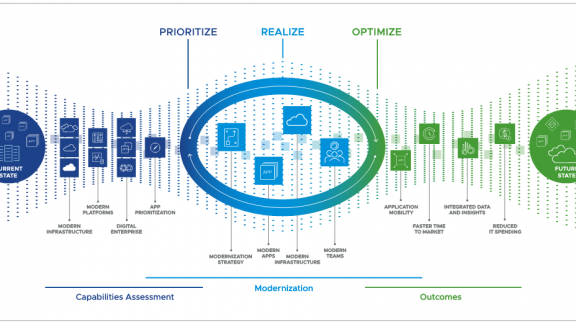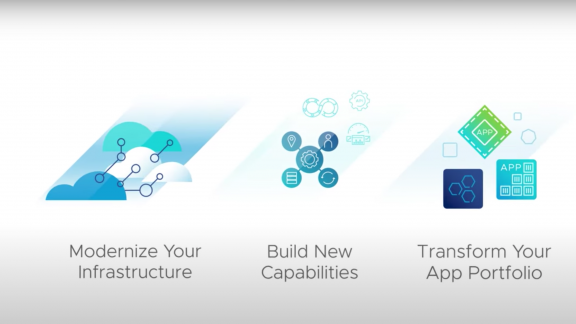In my last blog, I described the best practices for an App and Cloud Modernization Framework. The framework is an approach for how to modernize an application portfolio while simultaneously deploying the technologies required to create a secure, resilient cloud ecosystem.

I discussed the capabilities of Modern Infrastructure, Modern Platforms and Digital Enterprise that IT and developers need to build, run and manage apps on any cloud infrastructure. To assess these capabilities, the framework includes an outcome-focused capabilities assessment model that evaluates an organization’s current state against their desired future state. The result is a documentation of the gaps in each area, the steps needed to close them, and an ROI for executing those steps.
In part 2 of our modernizing apps and cloud series, I’ll cover the benefits of an outcome-focused gap analysis. Plus, I’ll list the capabilities IT and developer teams can expect from Modern Infrastructure, Modern Platforms and Digital Enterprise.

What to expect from an outcome-focused gap analysis
A gap analysis is a structured session for business and IT stakeholders. Team members identify the outcomes they want to achieve and uncover the obstacles to achieving those outcomes. At VMware, we use industry-standard CMMI models as the basis for assessment activities. During a half-day workshop, we use our automated tool to capture data in real time and map out an “as is, to be” gap analysis of an organization’s capabilities across the three areas – Modern Infrastructure, Modern Platforms and Digital Enterprise.

Modern Infrastructure
The assessment captures Modern Infrastructure capabilities across cloud infrastructure, whether it’s public, private or multi-cloud. An optimal Modern Infrastructure performs the following functions:
- Offers cloud consumers self-service via an IT portal
- Fulfills requests for resources via automated provisioning
- Provides application infrastructure resiliency that withstands component-level failures
- Publishes costs to users
- Enables applications to consume cloud-based resources on demand
- Governs cost, efficiency and security to optimize asset usage and ensure compliance across private and public clouds
- Moves apps and data between clouds with little to no downtime
- Provides access to cloud-native services in public clouds
- Ensures applications can be deployed to multiple different clouds with no changes to code
Modern Platforms
Modern Platforms reduce app complexity through abstraction interfaces, enable apps to operate on diverse data sets, and allow IT Ops to apply modern software engineering concepts to managing systems. Modern Platforms achieve and facilitate the following functions:
- Govern data and analytics that cover data definition, discovery, tools, etc.
- House a data and analytics lineage that records what happens with data and why
- Move data between systems through data pipelines within a microservices-based architecture
- Gather actionable insights through data science
- Use prescriptive analytics to predict actions and identify next steps
- Operate a standard platform across all clouds
- Provide the same runtime across clouds in a consistent abstraction layer
- Enable developers to test how new features and upgrades work in a production environment via managed rollouts
- Provide automated access for developers to environments and resources based on corporate policies
- Support application scaling as part of deployment with resources consumed as needed
Digital Enterprise
Digital Enterprise addresses how well IT and development teams support modern software development and application methodologies, and their ability to deliver and manage any app on any cloud on any device. Digital Enterprise performs the tasks below:
- Adhere to DevSecOps best practices, such as agile development, continuous integration, continuous delivery, security integration into development processes, and automated software delivery
- Build and use microservices
- Incorporate site reliability engineering practices into the development org
- Replatform or refactor legacy applications
- Build API libraries and API-driven applications
- Identify problems in distributed systems and provide actionable information to make corrections
- Create serverless code that is event-triggered and instantly scalable
Gap analysis deliverables
The deliverables from the workshop include a high-level capabilities assessment of the current state; timelines and workstream priorities; and a KPI Impact Analysis that shows the results when all the gaps are closed.

The minimum savings for each KPI are based on reaching the desired state and closing the gaps prioritized during the workshop. The maximum savings are based on reaching the top state for all competencies.
The average impacts are indicative of the overall improvement in efficiency and effectiveness of IT that could be experienced after closing the gaps. The maximum impact is what could be realized if all the competencies are achieved at the maximum capability level. The averages are calculated by dividing the sum of all the KPIs’ minimum and maximum value by seven.
The data behind the KPIs is derived from industry standard heuristics combined with customer project results based on years of implementing app and cloud modernization initiatives with VMware Professionals Services.

More to come
Check back for my next blog where I‘ll dig into the modernization process – Prioritize, Realize and Optimize. Download the VMware App and Cloud Modernization Services eBook and visit VMware Professional Services to learn more about VMware’s unique approach to modernization.




